Factors Influencing Employee Retention: A Research Outline (BUSN20016)
VerifiedAdded on 2020/04/01
|22
|4609
|86
Report
AI Summary
This research outline investigates the critical issue of employee turnover within organizations. The study aims to identify factors that cause employees to leave their jobs, including compensation, lack of motivation, poor leadership, and inadequate working conditions. The research will explore the impact of employee turnover on organizational productivity, morale, and financial stability. The methodology involves qualitative research, using LinkedIn, interviews, questionnaires, and social media to gather primary data from individuals with experience changing jobs. The research questions address employee motivation, ambition, compensation impact, and organizational strategies for retention. The expected outcomes include identifying key drivers of turnover and actionable recommendations for organizations to improve employee retention. The conceptual framework highlights job security, financial security, and a comfortable working environment as key factors influencing employee satisfaction and commitment. The research is justified by the significant costs associated with employee turnover and the need for organizations to understand and mitigate this challenge. The report is structured to include an introduction, problem statement, research objectives, methodology, literature review, and expected research output.
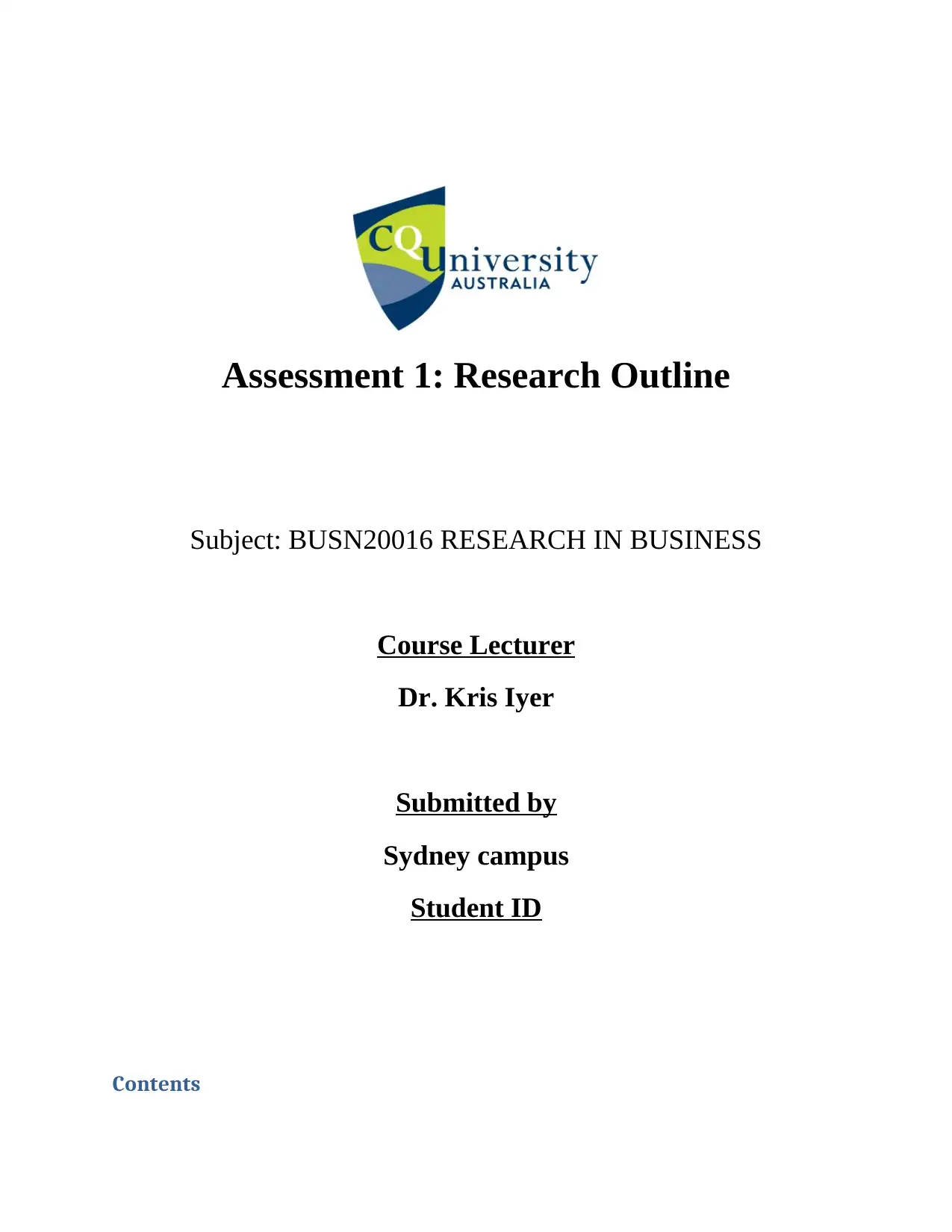
Assessment 1: Research Outline
Subject: BUSN20016 RESEARCH IN BUSINESS
Course Lecturer
Dr. Kris Iyer
Submitted by
Sydney campus
Student ID
Contents
Subject: BUSN20016 RESEARCH IN BUSINESS
Course Lecturer
Dr. Kris Iyer
Submitted by
Sydney campus
Student ID
Contents
Paraphrase This Document
Need a fresh take? Get an instant paraphrase of this document with our AI Paraphraser
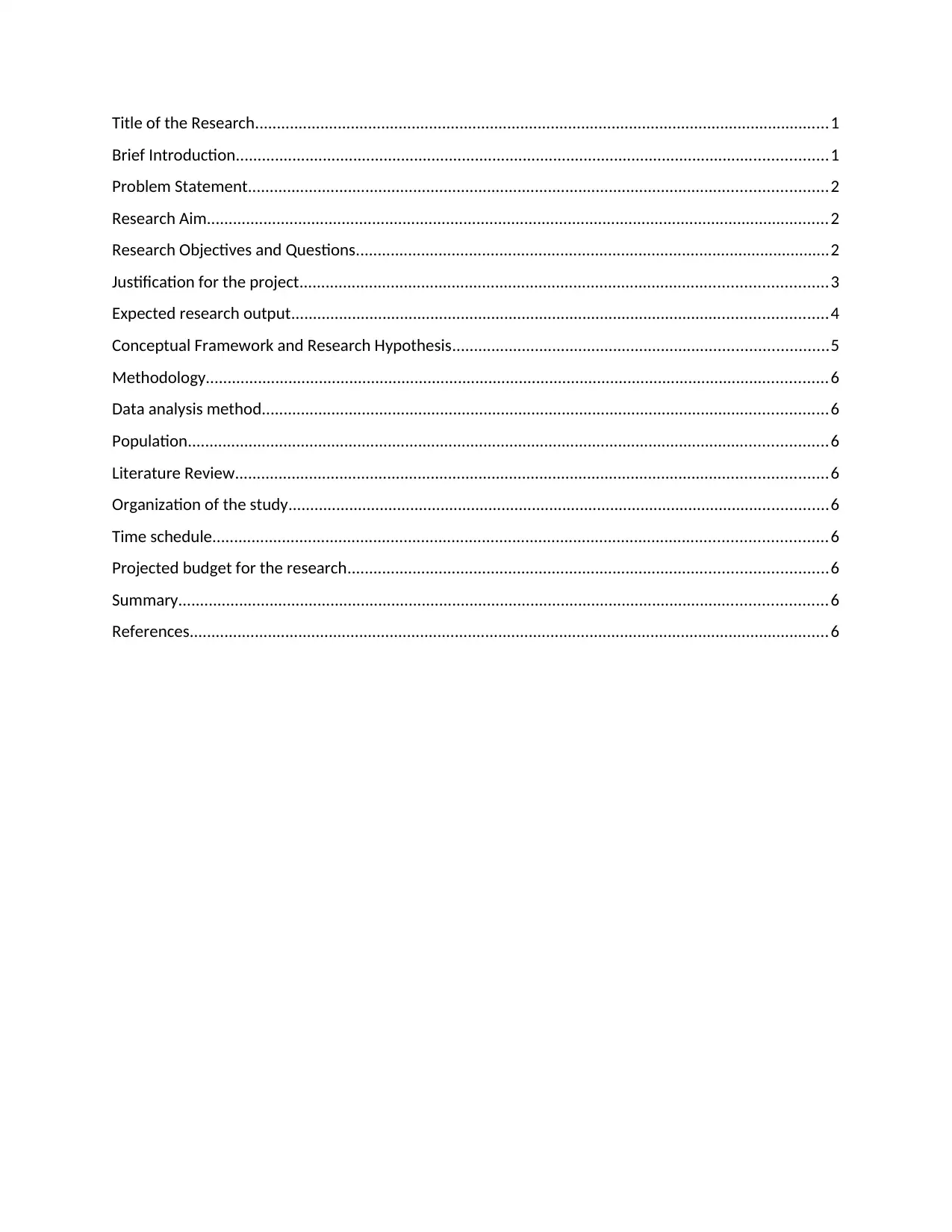
Title of the Research....................................................................................................................................1
Brief Introduction........................................................................................................................................1
Problem Statement.....................................................................................................................................2
Research Aim...............................................................................................................................................2
Research Objectives and Questions.............................................................................................................2
Justification for the project.........................................................................................................................3
Expected research output...........................................................................................................................4
Conceptual Framework and Research Hypothesis......................................................................................5
Methodology...............................................................................................................................................6
Data analysis method..................................................................................................................................6
Population...................................................................................................................................................6
Literature Review........................................................................................................................................6
Organization of the study............................................................................................................................6
Time schedule.............................................................................................................................................6
Projected budget for the research..............................................................................................................6
Summary.....................................................................................................................................................6
References...................................................................................................................................................6
Brief Introduction........................................................................................................................................1
Problem Statement.....................................................................................................................................2
Research Aim...............................................................................................................................................2
Research Objectives and Questions.............................................................................................................2
Justification for the project.........................................................................................................................3
Expected research output...........................................................................................................................4
Conceptual Framework and Research Hypothesis......................................................................................5
Methodology...............................................................................................................................................6
Data analysis method..................................................................................................................................6
Population...................................................................................................................................................6
Literature Review........................................................................................................................................6
Organization of the study............................................................................................................................6
Time schedule.............................................................................................................................................6
Projected budget for the research..............................................................................................................6
Summary.....................................................................................................................................................6
References...................................................................................................................................................6
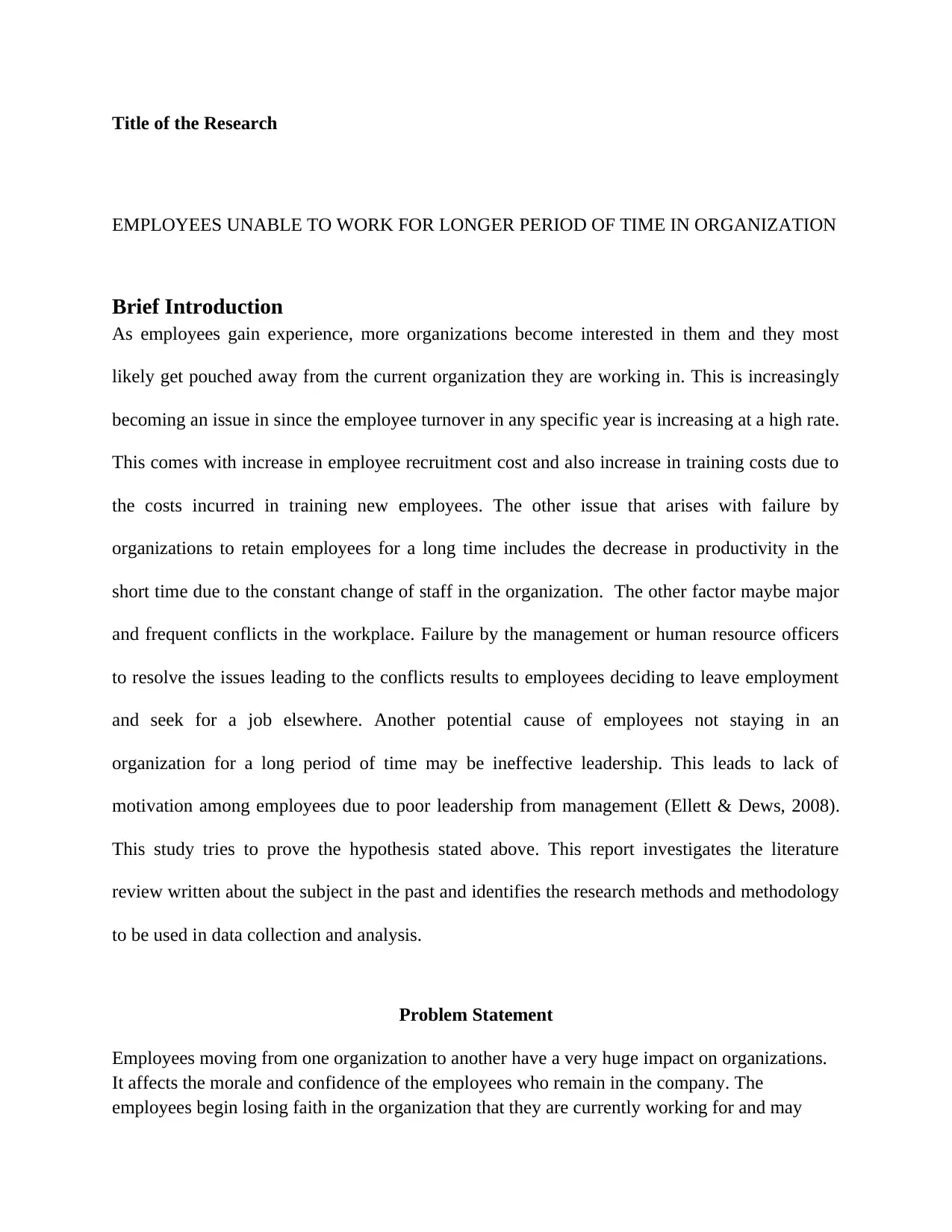
Title of the Research
EMPLOYEES UNABLE TO WORK FOR LONGER PERIOD OF TIME IN ORGANIZATION
Brief Introduction
As employees gain experience, more organizations become interested in them and they most
likely get pouched away from the current organization they are working in. This is increasingly
becoming an issue in since the employee turnover in any specific year is increasing at a high rate.
This comes with increase in employee recruitment cost and also increase in training costs due to
the costs incurred in training new employees. The other issue that arises with failure by
organizations to retain employees for a long time includes the decrease in productivity in the
short time due to the constant change of staff in the organization. The other factor maybe major
and frequent conflicts in the workplace. Failure by the management or human resource officers
to resolve the issues leading to the conflicts results to employees deciding to leave employment
and seek for a job elsewhere. Another potential cause of employees not staying in an
organization for a long period of time may be ineffective leadership. This leads to lack of
motivation among employees due to poor leadership from management (Ellett & Dews, 2008).
This study tries to prove the hypothesis stated above. This report investigates the literature
review written about the subject in the past and identifies the research methods and methodology
to be used in data collection and analysis.
Problem Statement
Employees moving from one organization to another have a very huge impact on organizations.
It affects the morale and confidence of the employees who remain in the company. The
employees begin losing faith in the organization that they are currently working for and may
EMPLOYEES UNABLE TO WORK FOR LONGER PERIOD OF TIME IN ORGANIZATION
Brief Introduction
As employees gain experience, more organizations become interested in them and they most
likely get pouched away from the current organization they are working in. This is increasingly
becoming an issue in since the employee turnover in any specific year is increasing at a high rate.
This comes with increase in employee recruitment cost and also increase in training costs due to
the costs incurred in training new employees. The other issue that arises with failure by
organizations to retain employees for a long time includes the decrease in productivity in the
short time due to the constant change of staff in the organization. The other factor maybe major
and frequent conflicts in the workplace. Failure by the management or human resource officers
to resolve the issues leading to the conflicts results to employees deciding to leave employment
and seek for a job elsewhere. Another potential cause of employees not staying in an
organization for a long period of time may be ineffective leadership. This leads to lack of
motivation among employees due to poor leadership from management (Ellett & Dews, 2008).
This study tries to prove the hypothesis stated above. This report investigates the literature
review written about the subject in the past and identifies the research methods and methodology
to be used in data collection and analysis.
Problem Statement
Employees moving from one organization to another have a very huge impact on organizations.
It affects the morale and confidence of the employees who remain in the company. The
employees begin losing faith in the organization that they are currently working for and may
⊘ This is a preview!⊘
Do you want full access?
Subscribe today to unlock all pages.

Trusted by 1+ million students worldwide
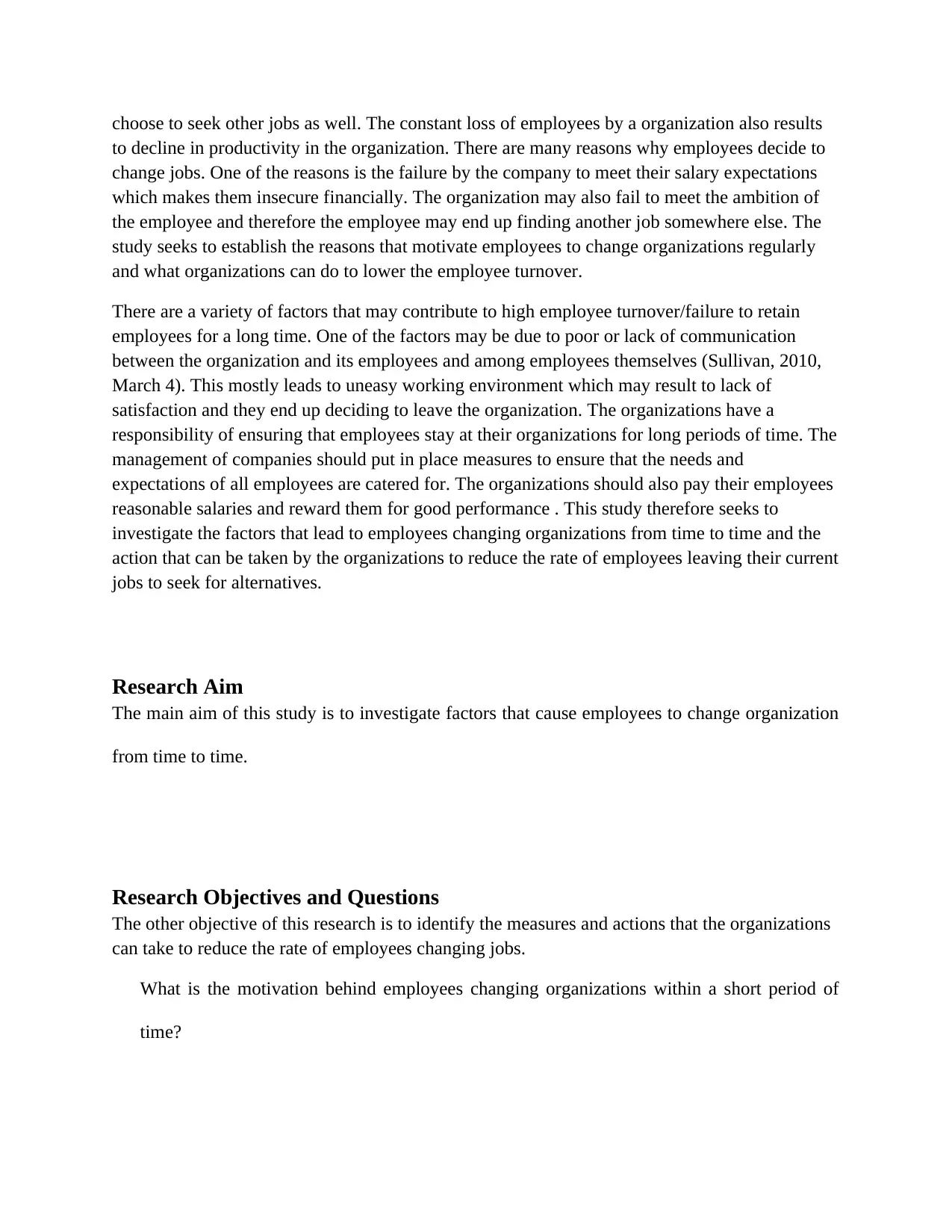
choose to seek other jobs as well. The constant loss of employees by a organization also results
to decline in productivity in the organization. There are many reasons why employees decide to
change jobs. One of the reasons is the failure by the company to meet their salary expectations
which makes them insecure financially. The organization may also fail to meet the ambition of
the employee and therefore the employee may end up finding another job somewhere else. The
study seeks to establish the reasons that motivate employees to change organizations regularly
and what organizations can do to lower the employee turnover.
There are a variety of factors that may contribute to high employee turnover/failure to retain
employees for a long time. One of the factors may be due to poor or lack of communication
between the organization and its employees and among employees themselves (Sullivan, 2010,
March 4). This mostly leads to uneasy working environment which may result to lack of
satisfaction and they end up deciding to leave the organization. The organizations have a
responsibility of ensuring that employees stay at their organizations for long periods of time. The
management of companies should put in place measures to ensure that the needs and
expectations of all employees are catered for. The organizations should also pay their employees
reasonable salaries and reward them for good performance . This study therefore seeks to
investigate the factors that lead to employees changing organizations from time to time and the
action that can be taken by the organizations to reduce the rate of employees leaving their current
jobs to seek for alternatives.
Research Aim
The main aim of this study is to investigate factors that cause employees to change organization
from time to time.
Research Objectives and Questions
The other objective of this research is to identify the measures and actions that the organizations
can take to reduce the rate of employees changing jobs.
What is the motivation behind employees changing organizations within a short period of
time?
to decline in productivity in the organization. There are many reasons why employees decide to
change jobs. One of the reasons is the failure by the company to meet their salary expectations
which makes them insecure financially. The organization may also fail to meet the ambition of
the employee and therefore the employee may end up finding another job somewhere else. The
study seeks to establish the reasons that motivate employees to change organizations regularly
and what organizations can do to lower the employee turnover.
There are a variety of factors that may contribute to high employee turnover/failure to retain
employees for a long time. One of the factors may be due to poor or lack of communication
between the organization and its employees and among employees themselves (Sullivan, 2010,
March 4). This mostly leads to uneasy working environment which may result to lack of
satisfaction and they end up deciding to leave the organization. The organizations have a
responsibility of ensuring that employees stay at their organizations for long periods of time. The
management of companies should put in place measures to ensure that the needs and
expectations of all employees are catered for. The organizations should also pay their employees
reasonable salaries and reward them for good performance . This study therefore seeks to
investigate the factors that lead to employees changing organizations from time to time and the
action that can be taken by the organizations to reduce the rate of employees leaving their current
jobs to seek for alternatives.
Research Aim
The main aim of this study is to investigate factors that cause employees to change organization
from time to time.
Research Objectives and Questions
The other objective of this research is to identify the measures and actions that the organizations
can take to reduce the rate of employees changing jobs.
What is the motivation behind employees changing organizations within a short period of
time?
Paraphrase This Document
Need a fresh take? Get an instant paraphrase of this document with our AI Paraphraser
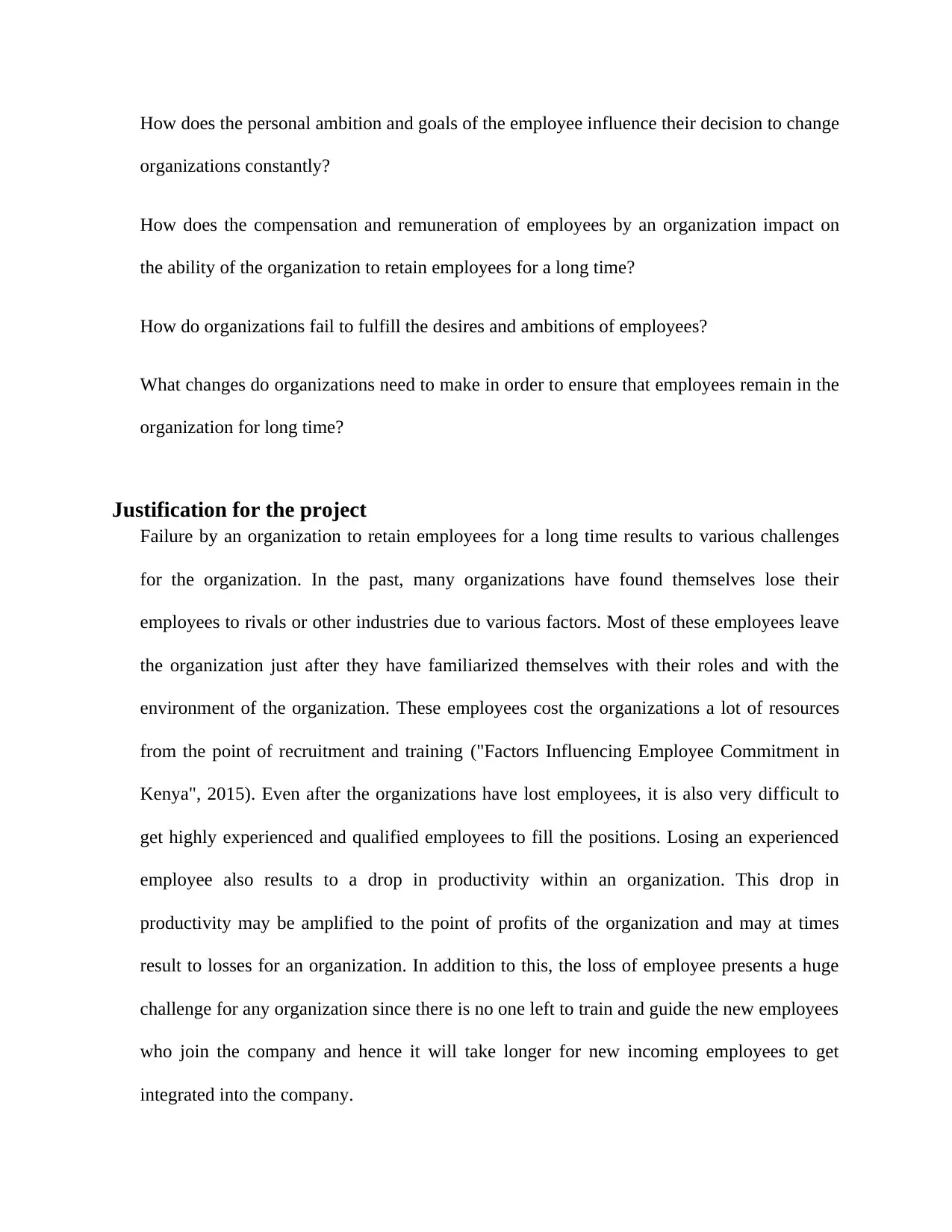
How does the personal ambition and goals of the employee influence their decision to change
organizations constantly?
How does the compensation and remuneration of employees by an organization impact on
the ability of the organization to retain employees for a long time?
How do organizations fail to fulfill the desires and ambitions of employees?
What changes do organizations need to make in order to ensure that employees remain in the
organization for long time?
Justification for the project
Failure by an organization to retain employees for a long time results to various challenges
for the organization. In the past, many organizations have found themselves lose their
employees to rivals or other industries due to various factors. Most of these employees leave
the organization just after they have familiarized themselves with their roles and with the
environment of the organization. These employees cost the organizations a lot of resources
from the point of recruitment and training ("Factors Influencing Employee Commitment in
Kenya", 2015). Even after the organizations have lost employees, it is also very difficult to
get highly experienced and qualified employees to fill the positions. Losing an experienced
employee also results to a drop in productivity within an organization. This drop in
productivity may be amplified to the point of profits of the organization and may at times
result to losses for an organization. In addition to this, the loss of employee presents a huge
challenge for any organization since there is no one left to train and guide the new employees
who join the company and hence it will take longer for new incoming employees to get
integrated into the company.
organizations constantly?
How does the compensation and remuneration of employees by an organization impact on
the ability of the organization to retain employees for a long time?
How do organizations fail to fulfill the desires and ambitions of employees?
What changes do organizations need to make in order to ensure that employees remain in the
organization for long time?
Justification for the project
Failure by an organization to retain employees for a long time results to various challenges
for the organization. In the past, many organizations have found themselves lose their
employees to rivals or other industries due to various factors. Most of these employees leave
the organization just after they have familiarized themselves with their roles and with the
environment of the organization. These employees cost the organizations a lot of resources
from the point of recruitment and training ("Factors Influencing Employee Commitment in
Kenya", 2015). Even after the organizations have lost employees, it is also very difficult to
get highly experienced and qualified employees to fill the positions. Losing an experienced
employee also results to a drop in productivity within an organization. This drop in
productivity may be amplified to the point of profits of the organization and may at times
result to losses for an organization. In addition to this, the loss of employee presents a huge
challenge for any organization since there is no one left to train and guide the new employees
who join the company and hence it will take longer for new incoming employees to get
integrated into the company.
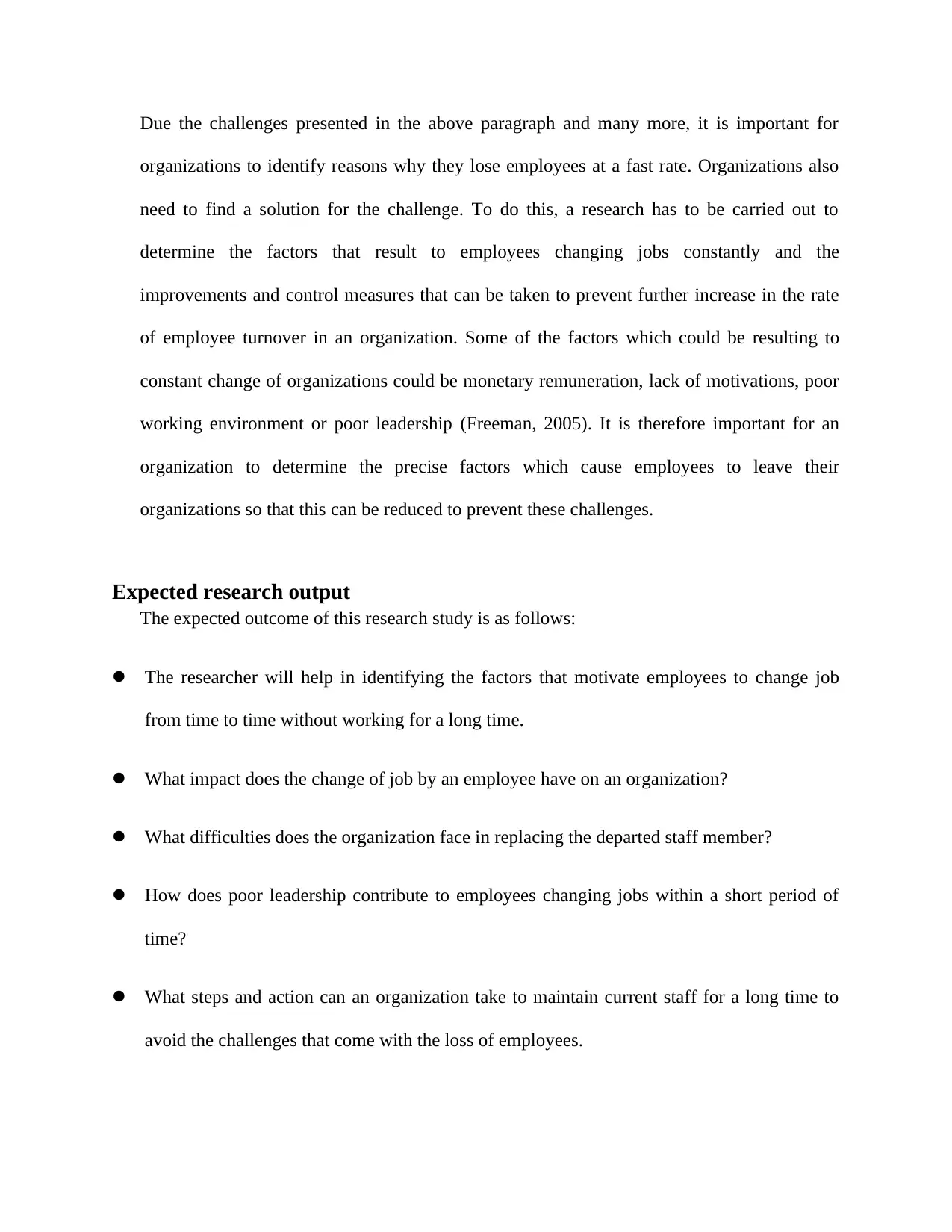
Due the challenges presented in the above paragraph and many more, it is important for
organizations to identify reasons why they lose employees at a fast rate. Organizations also
need to find a solution for the challenge. To do this, a research has to be carried out to
determine the factors that result to employees changing jobs constantly and the
improvements and control measures that can be taken to prevent further increase in the rate
of employee turnover in an organization. Some of the factors which could be resulting to
constant change of organizations could be monetary remuneration, lack of motivations, poor
working environment or poor leadership (Freeman, 2005). It is therefore important for an
organization to determine the precise factors which cause employees to leave their
organizations so that this can be reduced to prevent these challenges.
Expected research output
The expected outcome of this research study is as follows:
The researcher will help in identifying the factors that motivate employees to change job
from time to time without working for a long time.
What impact does the change of job by an employee have on an organization?
What difficulties does the organization face in replacing the departed staff member?
How does poor leadership contribute to employees changing jobs within a short period of
time?
What steps and action can an organization take to maintain current staff for a long time to
avoid the challenges that come with the loss of employees.
organizations to identify reasons why they lose employees at a fast rate. Organizations also
need to find a solution for the challenge. To do this, a research has to be carried out to
determine the factors that result to employees changing jobs constantly and the
improvements and control measures that can be taken to prevent further increase in the rate
of employee turnover in an organization. Some of the factors which could be resulting to
constant change of organizations could be monetary remuneration, lack of motivations, poor
working environment or poor leadership (Freeman, 2005). It is therefore important for an
organization to determine the precise factors which cause employees to leave their
organizations so that this can be reduced to prevent these challenges.
Expected research output
The expected outcome of this research study is as follows:
The researcher will help in identifying the factors that motivate employees to change job
from time to time without working for a long time.
What impact does the change of job by an employee have on an organization?
What difficulties does the organization face in replacing the departed staff member?
How does poor leadership contribute to employees changing jobs within a short period of
time?
What steps and action can an organization take to maintain current staff for a long time to
avoid the challenges that come with the loss of employees.
⊘ This is a preview!⊘
Do you want full access?
Subscribe today to unlock all pages.

Trusted by 1+ million students worldwide
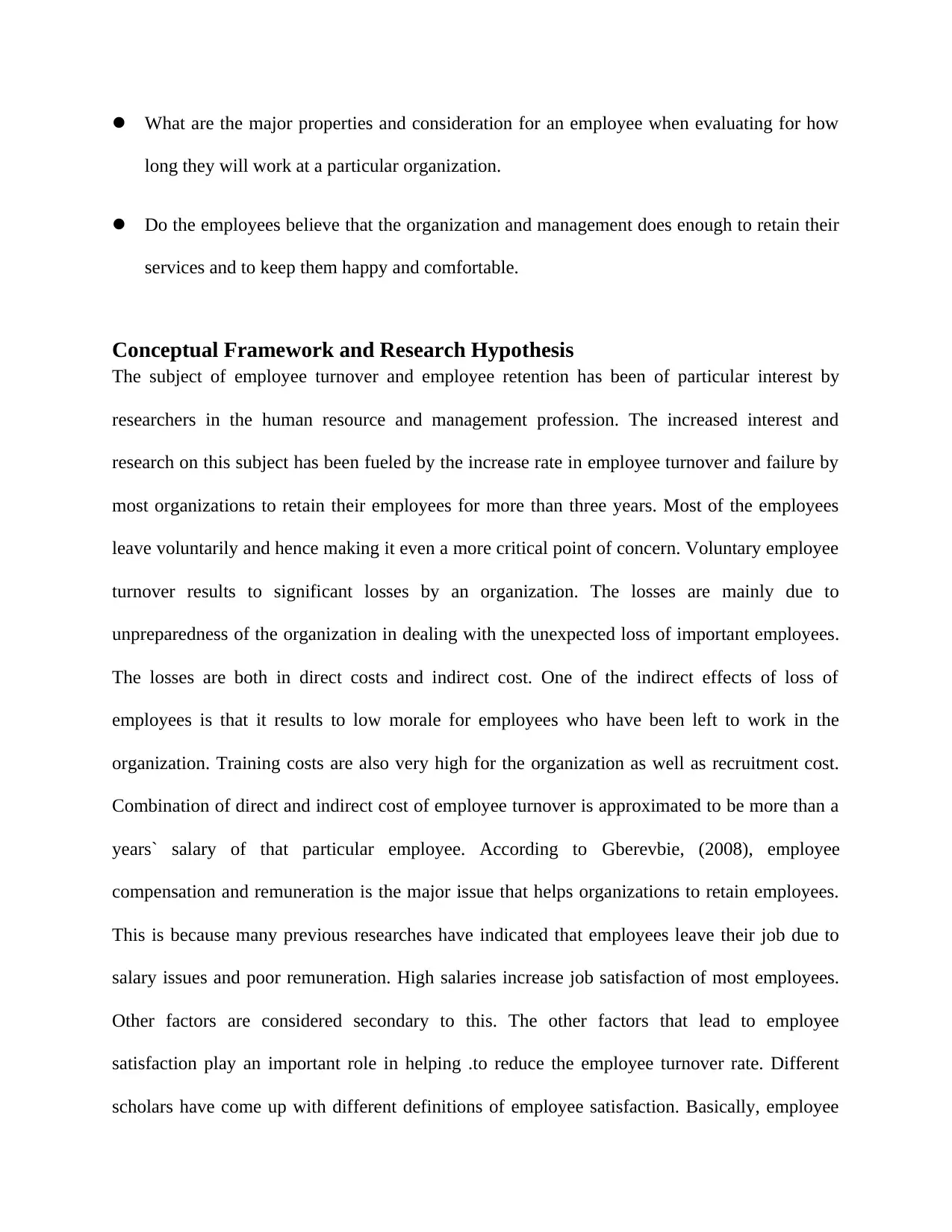
What are the major properties and consideration for an employee when evaluating for how
long they will work at a particular organization.
Do the employees believe that the organization and management does enough to retain their
services and to keep them happy and comfortable.
Conceptual Framework and Research Hypothesis
The subject of employee turnover and employee retention has been of particular interest by
researchers in the human resource and management profession. The increased interest and
research on this subject has been fueled by the increase rate in employee turnover and failure by
most organizations to retain their employees for more than three years. Most of the employees
leave voluntarily and hence making it even a more critical point of concern. Voluntary employee
turnover results to significant losses by an organization. The losses are mainly due to
unpreparedness of the organization in dealing with the unexpected loss of important employees.
The losses are both in direct costs and indirect cost. One of the indirect effects of loss of
employees is that it results to low morale for employees who have been left to work in the
organization. Training costs are also very high for the organization as well as recruitment cost.
Combination of direct and indirect cost of employee turnover is approximated to be more than a
years` salary of that particular employee. According to Gberevbie, (2008), employee
compensation and remuneration is the major issue that helps organizations to retain employees.
This is because many previous researches have indicated that employees leave their job due to
salary issues and poor remuneration. High salaries increase job satisfaction of most employees.
Other factors are considered secondary to this. The other factors that lead to employee
satisfaction play an important role in helping .to reduce the employee turnover rate. Different
scholars have come up with different definitions of employee satisfaction. Basically, employee
long they will work at a particular organization.
Do the employees believe that the organization and management does enough to retain their
services and to keep them happy and comfortable.
Conceptual Framework and Research Hypothesis
The subject of employee turnover and employee retention has been of particular interest by
researchers in the human resource and management profession. The increased interest and
research on this subject has been fueled by the increase rate in employee turnover and failure by
most organizations to retain their employees for more than three years. Most of the employees
leave voluntarily and hence making it even a more critical point of concern. Voluntary employee
turnover results to significant losses by an organization. The losses are mainly due to
unpreparedness of the organization in dealing with the unexpected loss of important employees.
The losses are both in direct costs and indirect cost. One of the indirect effects of loss of
employees is that it results to low morale for employees who have been left to work in the
organization. Training costs are also very high for the organization as well as recruitment cost.
Combination of direct and indirect cost of employee turnover is approximated to be more than a
years` salary of that particular employee. According to Gberevbie, (2008), employee
compensation and remuneration is the major issue that helps organizations to retain employees.
This is because many previous researches have indicated that employees leave their job due to
salary issues and poor remuneration. High salaries increase job satisfaction of most employees.
Other factors are considered secondary to this. The other factors that lead to employee
satisfaction play an important role in helping .to reduce the employee turnover rate. Different
scholars have come up with different definitions of employee satisfaction. Basically, employee
Paraphrase This Document
Need a fresh take? Get an instant paraphrase of this document with our AI Paraphraser
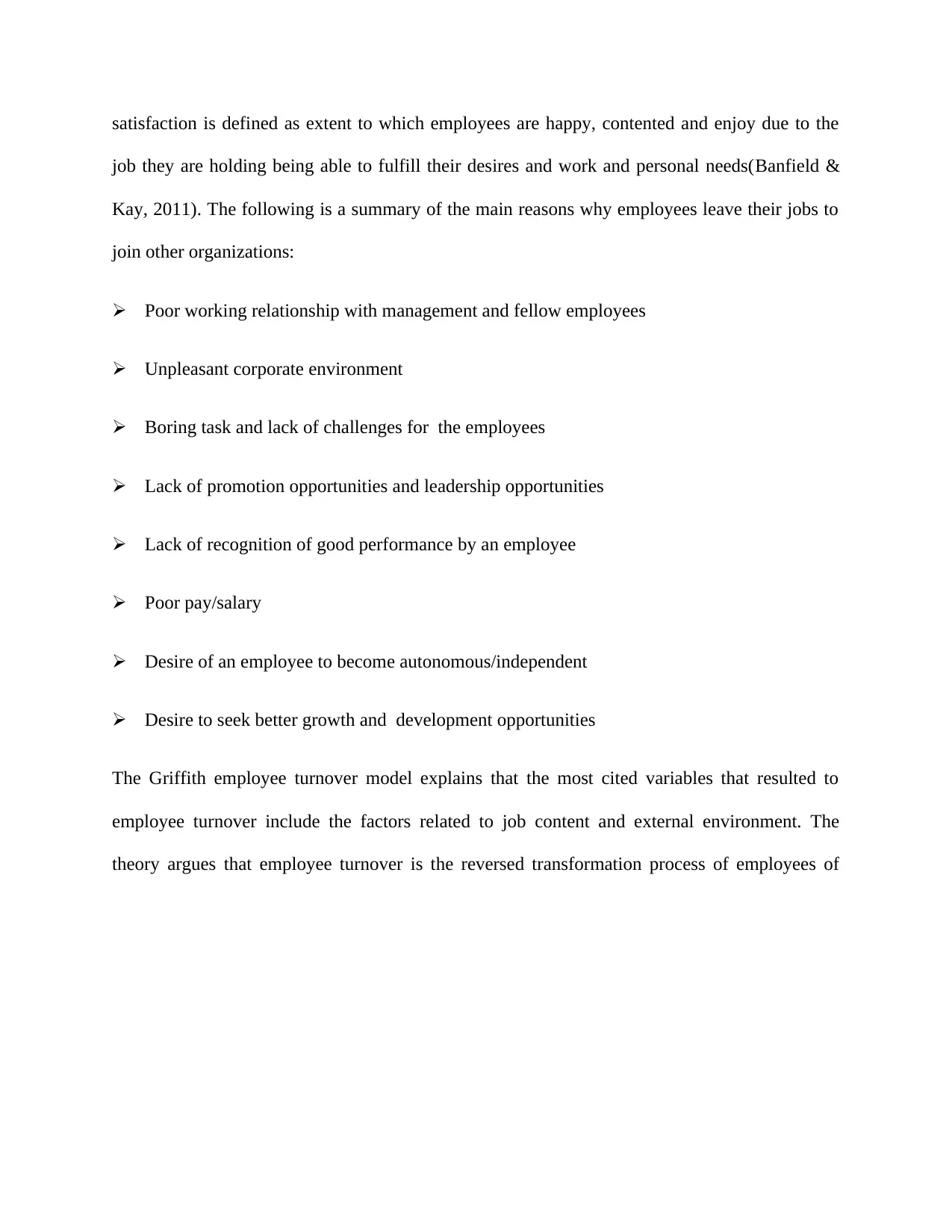
satisfaction is defined as extent to which employees are happy, contented and enjoy due to the
job they are holding being able to fulfill their desires and work and personal needs(Banfield &
Kay, 2011). The following is a summary of the main reasons why employees leave their jobs to
join other organizations:
Poor working relationship with management and fellow employees
Unpleasant corporate environment
Boring task and lack of challenges for the employees
Lack of promotion opportunities and leadership opportunities
Lack of recognition of good performance by an employee
Poor pay/salary
Desire of an employee to become autonomous/independent
Desire to seek better growth and development opportunities
The Griffith employee turnover model explains that the most cited variables that resulted to
employee turnover include the factors related to job content and external environment. The
theory argues that employee turnover is the reversed transformation process of employees of
job they are holding being able to fulfill their desires and work and personal needs(Banfield &
Kay, 2011). The following is a summary of the main reasons why employees leave their jobs to
join other organizations:
Poor working relationship with management and fellow employees
Unpleasant corporate environment
Boring task and lack of challenges for the employees
Lack of promotion opportunities and leadership opportunities
Lack of recognition of good performance by an employee
Poor pay/salary
Desire of an employee to become autonomous/independent
Desire to seek better growth and development opportunities
The Griffith employee turnover model explains that the most cited variables that resulted to
employee turnover include the factors related to job content and external environment. The
theory argues that employee turnover is the reversed transformation process of employees of
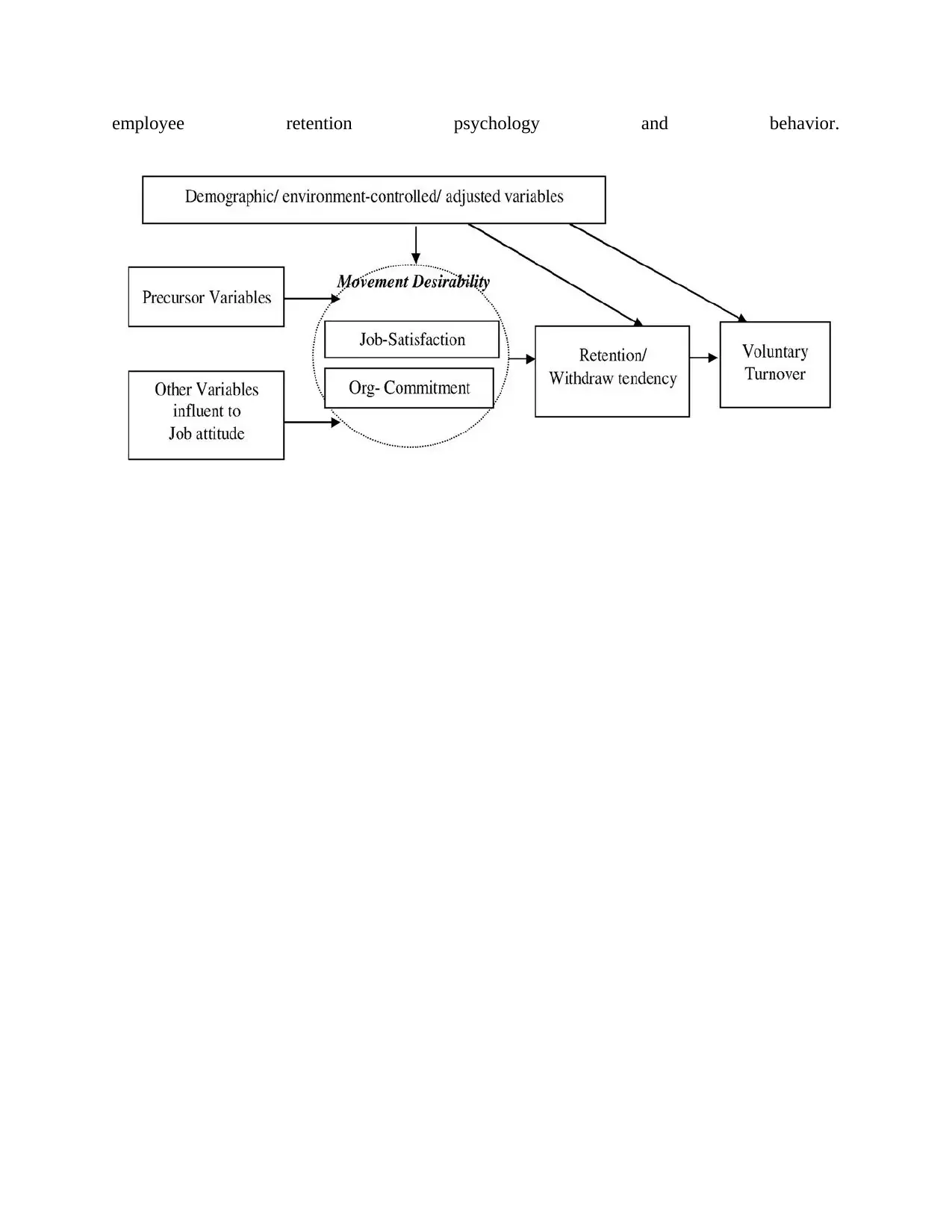
employee retention psychology and behavior.
⊘ This is a preview!⊘
Do you want full access?
Subscribe today to unlock all pages.

Trusted by 1+ million students worldwide
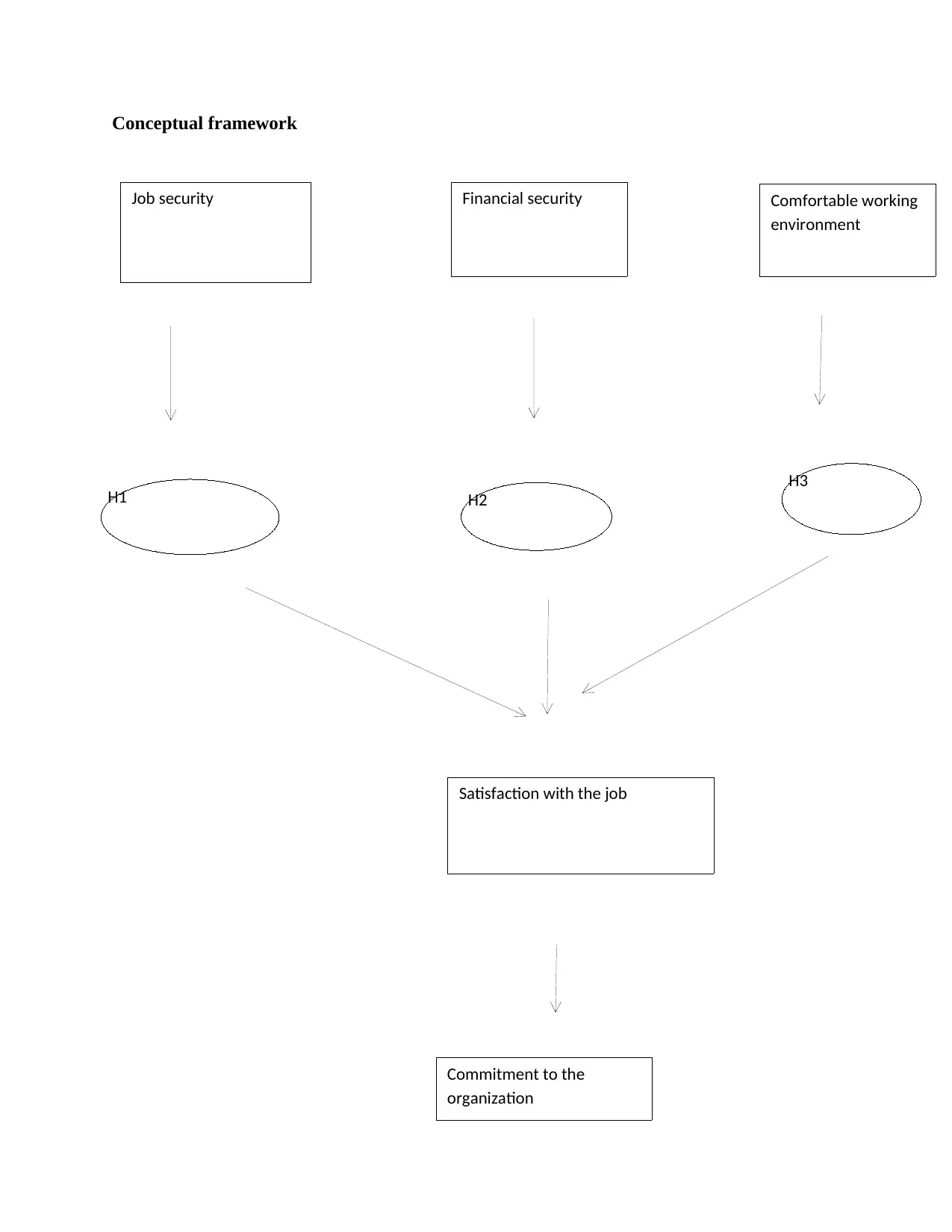
Conceptual framework
Job security Financial security Comfortable working
environment
H2H1 H3
Satisfaction with the job
Commitment to the
organization
Job security Financial security Comfortable working
environment
H2H1 H3
Satisfaction with the job
Commitment to the
organization
Paraphrase This Document
Need a fresh take? Get an instant paraphrase of this document with our AI Paraphraser
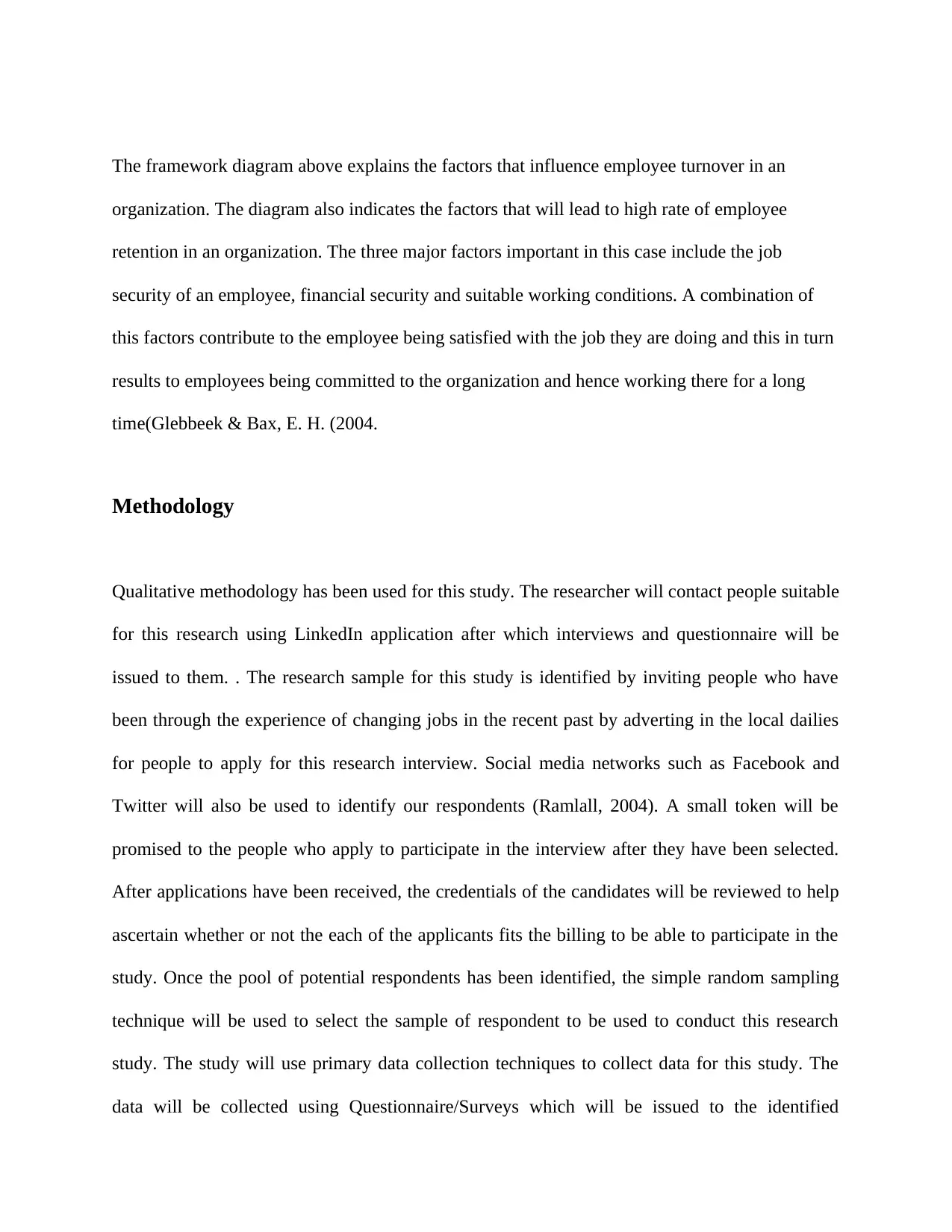
The framework diagram above explains the factors that influence employee turnover in an
organization. The diagram also indicates the factors that will lead to high rate of employee
retention in an organization. The three major factors important in this case include the job
security of an employee, financial security and suitable working conditions. A combination of
this factors contribute to the employee being satisfied with the job they are doing and this in turn
results to employees being committed to the organization and hence working there for a long
time(Glebbeek & Bax, E. H. (2004.
Methodology
Qualitative methodology has been used for this study. The researcher will contact people suitable
for this research using LinkedIn application after which interviews and questionnaire will be
issued to them. . The research sample for this study is identified by inviting people who have
been through the experience of changing jobs in the recent past by adverting in the local dailies
for people to apply for this research interview. Social media networks such as Facebook and
Twitter will also be used to identify our respondents (Ramlall, 2004). A small token will be
promised to the people who apply to participate in the interview after they have been selected.
After applications have been received, the credentials of the candidates will be reviewed to help
ascertain whether or not the each of the applicants fits the billing to be able to participate in the
study. Once the pool of potential respondents has been identified, the simple random sampling
technique will be used to select the sample of respondent to be used to conduct this research
study. The study will use primary data collection techniques to collect data for this study. The
data will be collected using Questionnaire/Surveys which will be issued to the identified
organization. The diagram also indicates the factors that will lead to high rate of employee
retention in an organization. The three major factors important in this case include the job
security of an employee, financial security and suitable working conditions. A combination of
this factors contribute to the employee being satisfied with the job they are doing and this in turn
results to employees being committed to the organization and hence working there for a long
time(Glebbeek & Bax, E. H. (2004.
Methodology
Qualitative methodology has been used for this study. The researcher will contact people suitable
for this research using LinkedIn application after which interviews and questionnaire will be
issued to them. . The research sample for this study is identified by inviting people who have
been through the experience of changing jobs in the recent past by adverting in the local dailies
for people to apply for this research interview. Social media networks such as Facebook and
Twitter will also be used to identify our respondents (Ramlall, 2004). A small token will be
promised to the people who apply to participate in the interview after they have been selected.
After applications have been received, the credentials of the candidates will be reviewed to help
ascertain whether or not the each of the applicants fits the billing to be able to participate in the
study. Once the pool of potential respondents has been identified, the simple random sampling
technique will be used to select the sample of respondent to be used to conduct this research
study. The study will use primary data collection techniques to collect data for this study. The
data will be collected using Questionnaire/Surveys which will be issued to the identified
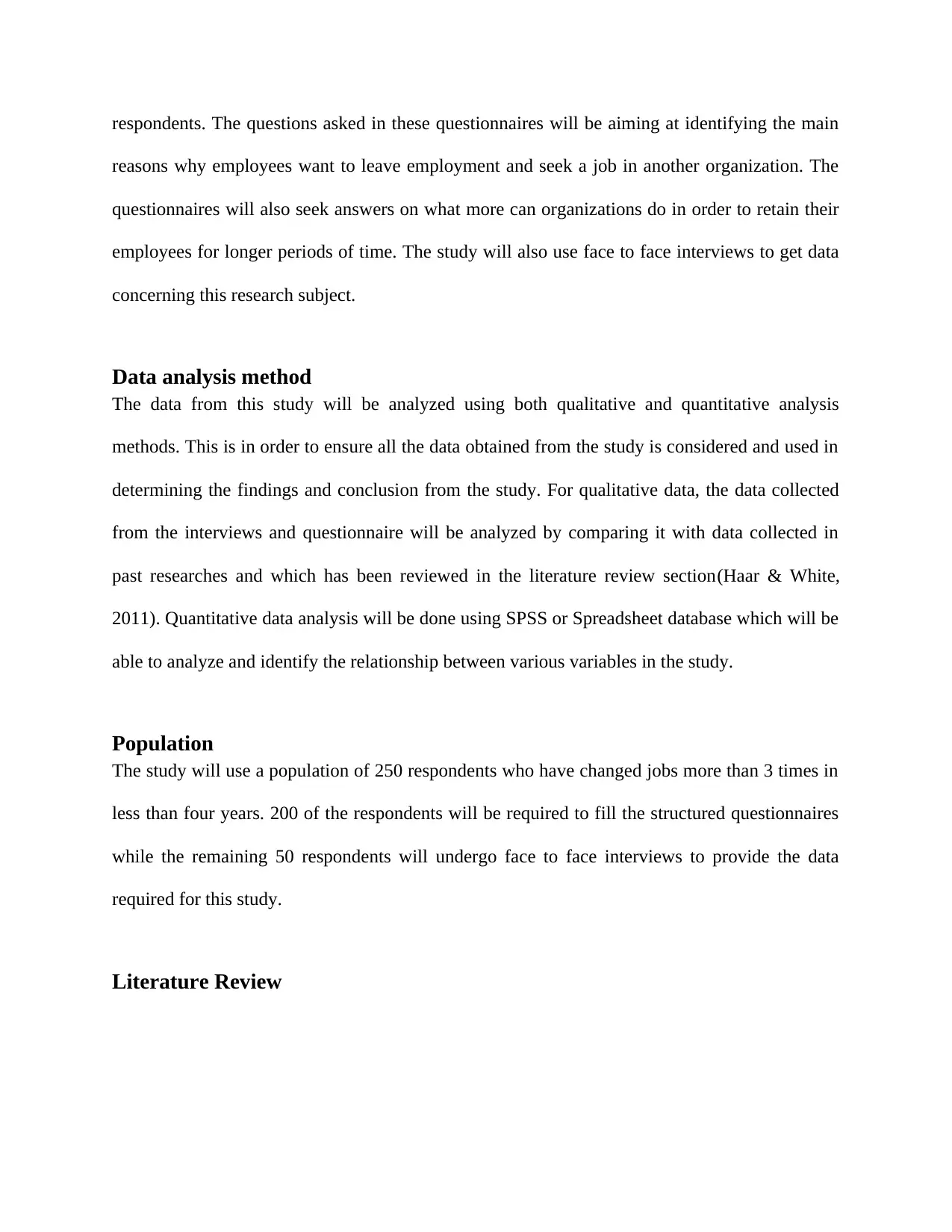
respondents. The questions asked in these questionnaires will be aiming at identifying the main
reasons why employees want to leave employment and seek a job in another organization. The
questionnaires will also seek answers on what more can organizations do in order to retain their
employees for longer periods of time. The study will also use face to face interviews to get data
concerning this research subject.
Data analysis method
The data from this study will be analyzed using both qualitative and quantitative analysis
methods. This is in order to ensure all the data obtained from the study is considered and used in
determining the findings and conclusion from the study. For qualitative data, the data collected
from the interviews and questionnaire will be analyzed by comparing it with data collected in
past researches and which has been reviewed in the literature review section(Haar & White,
2011). Quantitative data analysis will be done using SPSS or Spreadsheet database which will be
able to analyze and identify the relationship between various variables in the study.
Population
The study will use a population of 250 respondents who have changed jobs more than 3 times in
less than four years. 200 of the respondents will be required to fill the structured questionnaires
while the remaining 50 respondents will undergo face to face interviews to provide the data
required for this study.
Literature Review
reasons why employees want to leave employment and seek a job in another organization. The
questionnaires will also seek answers on what more can organizations do in order to retain their
employees for longer periods of time. The study will also use face to face interviews to get data
concerning this research subject.
Data analysis method
The data from this study will be analyzed using both qualitative and quantitative analysis
methods. This is in order to ensure all the data obtained from the study is considered and used in
determining the findings and conclusion from the study. For qualitative data, the data collected
from the interviews and questionnaire will be analyzed by comparing it with data collected in
past researches and which has been reviewed in the literature review section(Haar & White,
2011). Quantitative data analysis will be done using SPSS or Spreadsheet database which will be
able to analyze and identify the relationship between various variables in the study.
Population
The study will use a population of 250 respondents who have changed jobs more than 3 times in
less than four years. 200 of the respondents will be required to fill the structured questionnaires
while the remaining 50 respondents will undergo face to face interviews to provide the data
required for this study.
Literature Review
⊘ This is a preview!⊘
Do you want full access?
Subscribe today to unlock all pages.

Trusted by 1+ million students worldwide
1 out of 22
Related Documents
Your All-in-One AI-Powered Toolkit for Academic Success.
+13062052269
info@desklib.com
Available 24*7 on WhatsApp / Email
![[object Object]](/_next/static/media/star-bottom.7253800d.svg)
Unlock your academic potential
Copyright © 2020–2025 A2Z Services. All Rights Reserved. Developed and managed by ZUCOL.





